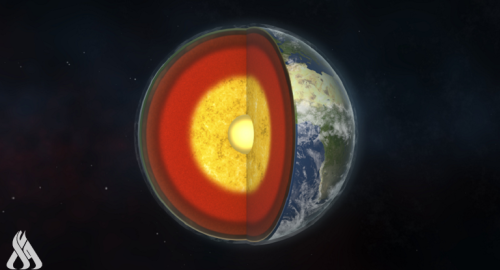
Geologists analyze two strange points discovered deep in the earth

- 15-03-2022, 10:17
INA- sources
The Earth’s interior is not a uniform pile of layers, deep within the thick middle layer are two massive thermochemical blobs.
To this day, scientists still don’t know where these massive structures came from or why the heights differ, but a new set of geodynamic models have landed on a possible answer to this last mystery.
These hidden reservoirs are located on opposite sides of the world, and based on the deep propagation of seismic waves, the point under the African continent is more than double that under the Pacific Ocean.
After conducting hundreds of simulations, the authors of the new study believe that the point under the African continent is less dense and less stable than its counterpart in the Pacific Ocean, which is why it is so high.
Geologist Qian Yuan from Arizona State University explains: “Our calculations found that the initial size of the points does not affect their height.
The height of the points is mostly controlled by their density and the viscosity of the surrounding mantle.
One of the main layers inside Earth is the hot, slightly sticky mess known as the mantle, a layer of silicate rock that lies between our planet’s core and crust.
While the mantle is mostly solid, it behaves somewhat like tar over longer time scales.
Over time, plumes of hot magma gradually rise through the mantle and are thought to contribute to volcanic activity at the planet’s surface.
So understanding what happens in the mantle is an important endeavor in geology.
The African and Pacific Ocean points were first discovered in the 1980s.
Scientifically speaking, these “super columns” are known as LLSVPs.
Compared to the Pacific LLSVP, the current study found that the African LLSVP extends about 1,000 kilometers (621 miles) higher, supporting earlier estimates.
This vast difference in elevation indicates that both points have different compositions. Perhaps the less stable nature of the African mounds, for example, could explain why there is such intense volcanic activity in some areas of the continent.
It can also affect the movement of tectonic plates, which float on the mantle.
Other seismic models have found that the African LLSVP extends up to 1,500 km above the outer core, while the Pacific LLSVP reaches a maximum elevation of 800 km.
In laboratory experiments seeking to reproduce the interior of the Earth, both the African and Pacific mounds appear to sway up and down through the mantle.
The authors of the current study say this supports their interpretation that African LLSVP may be unstable, and the same could be true for Pacific LLSVP, although their models did not show this.
The different combinations of Pacific and African LLSVPs can also be explained by their origins.
Scientists still don’t know where these blobs came from, but there are two main theories. One is that the mounds are made of submerged tectonic plates, which slide into the mantle, are massively heated and gradually fall downward, contributing to the point’s formation.
Another theory says that the blobs are remnants of an ancient collision between Earth and the protoplanet Theia, which gave us the Moon. The theories aren’t mutually exclusive either. For example, Theia may have contributed more to one point; This may be part of the reason why they look so different today.
Source: agencies
Russia foils assassination attempts on defense officials
- International
- 01:22
US Central Command: We killed ISIS terrorist leader Abu Yusuf in Syria
- International
- 24/12/20
Liverpool compete with Real Madrid to sign Olympique Lyonnais star
- Security
- 24/12/19
7 ISIS elements arrested in Kirkuk
- Security
- 24/12/20












